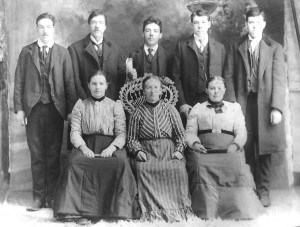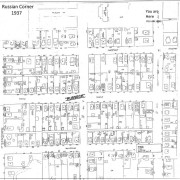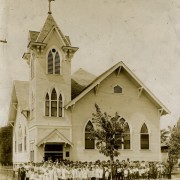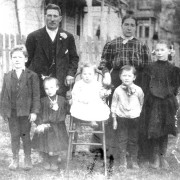Welcome to Walla Walla’s Germantown History Website
Germans from Russia
During the mid 1700’s, Catherine the Great of Russia granted German immigrants concessions to settle in Russia in the Volga River region. Later colonies were established in the Ukraine and Black Sea area.
Germany was beset by wars, poverty and hunger, and many Germans saw this as a opportunity, hoping these settlements would bring them a better life.
The Russian government gave them land for villages and farming. They were allowed to govern their own settlements and maintain their own religions and language, and were not required to serve in the military.
In 1874, the military service concession was rescinded, and their young men were required to serve in the Russian army. During the same period, the U.S. sent recruiters to Germany and Russia offering many of the same concessions the Germans had enjoyed in Russia. In 1890, Germans from Russia were the second largest immigrant group to come to the Northwest.
Religious freedom was a strong motivation to emigrate; many were Lutheran and these immigrants brought their faith with them to the U.S.
Walla Walla’s Russian Corner
From 1882-1920, many of these families settled in the southwest part of Walla Walla. The largest neighborhood was west of Third Avenue and south of Chestnut Street, which became known as Germantown to others in Walla Walla, but was called Russaecke (Russische Ecke—Russian Corner) by the approximately 300 German families who resided in Walla Walla. Garrison Creek which runs there was known as the “Little Volga.
The German immigrants from the Volga region of Russia came primarily from the “Bergseite” (hillside) area of Lutheran villages, including Frank, Walter, Kolb, Norka, Hussenbach, and Kautz, all located southwest of the governmental city of Saratov on the Volga River, and from Jagodnaja Poljana, north of Saratov.
The primary area of Russaecke was bordered by Third Avenue on the east, Chase Avenue on the west, Chestnut Street on the north, and Willard Street on the south. Outside of this neighborhood lived many more Germans from Russia, particularly in the southwest Walla Walla homes from Second all the way to the railroad tracks at Thirteenth Avenue, including Chestnut, Willow, Emma, Sprague, Military, Birch, Poplar, and Alder. Links to maps of several of these neighborhoods including city directory information from 1937 can be found in the Additional Resources box to the right.
These immigrants built homes, corner grocery stores and churches. Their children attended local schools, and were also required to attend a Sabbath school on Saturdays in their churches.
German-Language Churches
German-language churches in Walla Walla included the Second German Congregational Church, first established in 1882 and reorganized in 1896 at 7th & Willow as Zion Lutheran Congregational Church, as well as the first German Methodist church in the Northwest, established here in 1883.
In 1888 the first Lutheran services were held in Walla Walla, out of which came Emmanuel Lutheran Church, also at 7th & Willow. In 1896 a split occurred in the congregation and several families withdrew to form Christ Lutheran Church on Maple Street, later relocated to a new building South Second.
In the early twentieth century there were said to be seven German churches in Walla Walla. English did not fully displace German in these churches until World War II.
Employment
The Germans from Russia and their descendants became staunch members of the WW community. Most of them quickly learned English, especially the men who worked at jobs on the railroad, street maintenance, carpentry, shoemaking, cutting sugar beets, picking hops, and other farm work.
The women maintained their own homes, while some worked as housekeepers and laundresses for the “English” ladies.
Some members of the community were fortunate enough to eventually open their own businesses. These included Johann Conrad Frank who in 1928 opened the Conrad Frank Construction Company and trained each of his sons to carry on his tradition of fine carpentry. That same year, John David Frank established a grocery store and meat market on Fourth Avenue in competition with a grocery on Maple Street opened earlier by the Hill family in about 1915.
Families of Germans from Russia in Walla Walla
The names of families of Germans from Russia who settled in Walla Walla from approximately 1882-1920 included:
- Alles, Amen, Anhorn,
- Benzel, Blehm, Brehm, Breightham, Butherus,
- Cilk / Zilk,
- Derr, Dewald, Dietz, Dippel, Dumle,
- Eckhardt, Ells / Ils, Engelmann, Erdmann, Ehrlich,
- Fiewig, Foltz, Frank, Frickel, Fries, Fox / Fuchs,
- Fritzler, Funk,
- Gabel, Geier, Geist, Gettmann, Gies, Gradwohl, Green,
- Haberer, Hamburg, Harding, Hardt, Hartung, Hartwig, Heberlein, Heagle, Hein, Heimbigner, Heinbigner, Hergert, Hill, Hoff, Hoffner, Holland, Holwager, Horst,
- Kanzler, Kimbel, Kindsvater / Kinsfather, Kissler, Kleweno, Knaub, Knaus, Knell, Knopf, Kohler,
- Lais, Laufer, Leichner, Linker, Litzenberger,
- Meininger, Michaelis, Michel, Mill, Miller,
- Mohr, Morhland,
- Neubauer,
- Ochs, Ostwald,
- Rahn, Raugust, Reiswig, Reiter, Rempel, Repp Rieker, Riehl, Rohn, Roth, Rutz,
- Salmeier, Sauer, Schaefer, Schafer, Schatzel, Schiffner, Schledewitz, Schmidt, Schneider, Schneidmiller, Schössler, Schreiber, Schreiner, Schuhart, Schwartzkopf, Seibel, Sept, Starkel, Steinmetz, Streck, Stumpf,
- Triebwasser,
- Volker,
- Wacker, Wagner, Walter, Weber, Weis, Weitz, Wilhelm, Wolf.
Walla Walla 2020 Historic Research & Plaque Project
Information on the Walla Walla 2020 Historic Research & Plaque Project is available here or by calling 509-522-0399.
Germantown History Panel
Aditional Resources
Germantown Walking Tour Brochure
Germantown Maps:
Center
South to Willard
West of 9th
West of Chase
A Garrison School Reunion Book, Graduating Classes of 1956-1960 (150MB PDF file)




